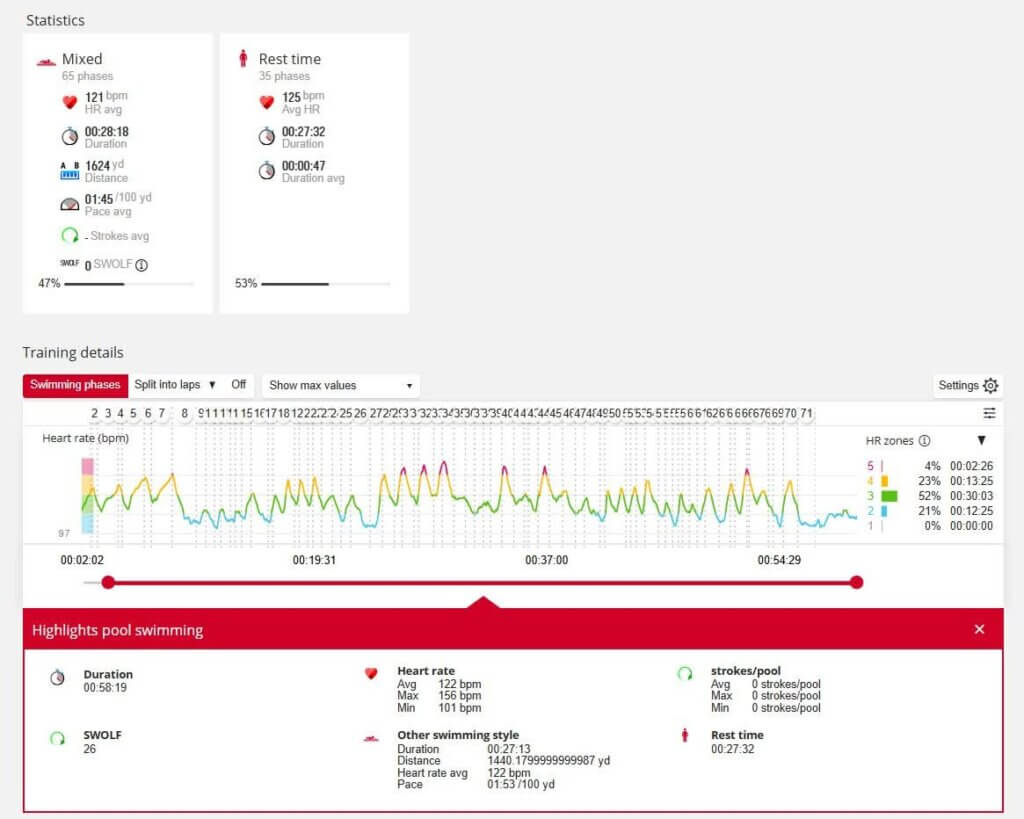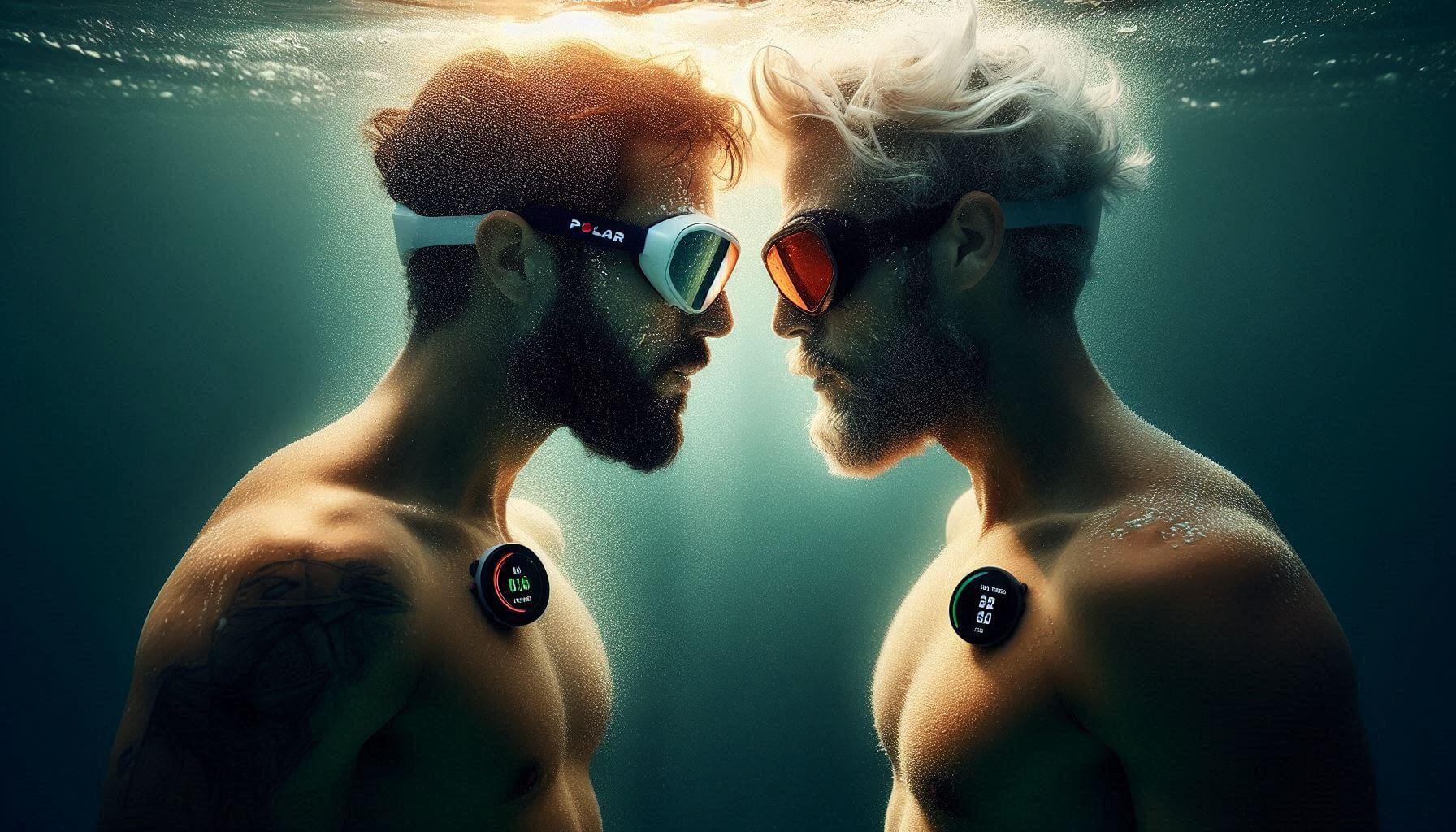Over four days of swim training, I evaluated multiple heart rate monitoring sensors and sport watches across various combinations to assess their accuracy, reliability, and performance in aquatic environments. The four days tests list:
The sport monitoring products compared during my swimming tests
- Polar Verity Sense is an optical heart rate monitor that provides you with maximum freedom of movement and multiple options for viewing and recording your workouts. How to wear it swimming:
- I use the optical sensor on the left arm at the top, since it is the best place for an optical sensor.
- Someone told me that Polar Verity Sense works better under the swim cap on your right or left temple. “A lot less noise when heart rate gets low and no lift of the sensor off the skin when swimming fast”. See some data at the end of the post.
- Apparently, wearing Verity Sense on temple attached to the swim goggles, as suggested by Polar manual, is the worst way for many, including me.
- Instead, Polar H10 is a chest based heart rate sensor that uses electrical (ECG) technology for high-accuracy heart rate measurement, even during intense exercise. Form many the best sensor on the market.
- The only real Polar H10 competitor, in his category, is Garmin HRM 600 electric heart rate sensor.
- Polar Vantage M3 against Polar H10. Vantage M3 has the GEN 4 sensor, the last version of Polar OHR sensors,
Day 1 Polar: Polar Verity Sense optical sensor vs Polar h10 electrical sensor.
Optical and electrical heart rate sensors can perform differently in water
The best sensor on dry condition is obviously Polar H10 electrical sensor. But Polar wrote a disclaimer for H10 and all the electrical sensors: “It’s good to notice that sea and pool water are very conductive, which may prevent the chest strap to detect heart rate impulses in water”.
For these reasons, before this test, I preferred to use Polar Verity Sense optical sensor, wearing it on the upper left arm. I used it because the optical sensor is more comfortable than the H10 chest sensor. This is true especially during fast swimming. Sometimes the chest strap can be moved by the water, you can prevent this with a stronger grip, but the comfort is even worse.
Furthermore, H10 was not projected well for underwater use, since it has only a water resistance WR30 (3 ATM). But, on the Polar site, they say that H10 can be used for swimming (and I am using it for swimming without any problem, until now).
Instead, Polar Verity Sense optical sensor has a water resistance WR 50 (5 ATM) and so it is not possible to ruin it swimming.
The equivalent and the real competitor of Polar H10 electrical heart sensor is Garmin HRM 600.
Polar H10 vs Garmin HRM 600 chest electrical sensor
HRM 600 Pro;
- It has WR 50 (5 ATM) waterproof certification.
HRM 600 Cons:
- It is more expensive.
- Gramin HRM 600 can be connected only to a Garmin smartwatch. Instead, Polar H10 can be connected to any smartwatch or gym machine that accept an external heart rate sensor, using either ANT+ or Bluetooth. For example, Polar H10 can be connected to all the Apple watches, improving their heart monitoring precision.
- The HRM 600 chest strap is fragile, especially the snaps. You can see in Garmin forum, it breaks very easily. Garmin is aware of the problem and in the future will hopefully improve the strap.
How I tested the two Polar’s sensor in a single swim training.
Obviously, I wore the two sensors simultaneously. Both the sensors recorded the training session in the internal memory, without connecting to an external device (smartwatch). I started the test at home, so I record also the short trip to the swimming pool.
My training session was:
- Warm-up for 20 minutes.
- Freestyle 100 meter: one sprint at 80% effort.
- Freestyle 50 meter: 3 sprint at 90% effort.
- Freestyle 25 meter: 2 sprint at 100% effort.
- Butterfly 25 meter: 3 sprint at 100% effort.
- Breaststroke underwater 25 meter: 3 times in apnea.
The swim training test results
On low heart rate zones, both the sensor performed very well with the same data. Instead, at high heart rate frequency, the electrical heart rate sensor H10 was much more accurate than the optical one.
You can evaluate the two heart rate sensor looking the at data I got when I connected the sensor to the App.
Heart rate zones
Verity Sense, upper arm optical sensor
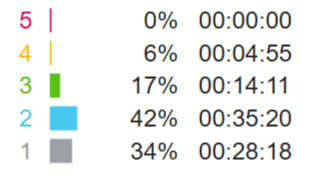
H10 chest elettrical sensor
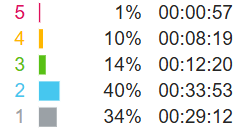
From the two pictures above, it is clear that during sprint training Verity Sense optical sensor start loosing heart rate beats above the zone 4 limit of 132 bpm. But the beats are not lost, they are counted in zone 3 and 2 that have a bigger total time with the optical sensor.
Instead, the h10 electrical sensor was able to record the acceleration of the sprints.
Constant speed or slow acceleration smae results
Swimming at almost constant speed or with slow acceleration, Verity Sense and H10 performed the same. This is a good news for the endurance training swimmer.
Beat Per Minute (bpm) charts
I have cut from the pictures below the first 21 minutes, the travel from home to the swimming pool. Instead, in the total times, for the five training cardio zones, the total zones times have more time in zone one, since they have also the travel from home to the swimming pool.


Maximum heart rate with Polar Verity Sense optical sensor, on the upper left arm, was 146 bpm.
Optical heart rate sensors comparison in each training phase:
- Warm-up for 20 minutes. No difference between optical and electrical sensors.
- Freestyle 100 meter: one sprint at 80% effort. Almost no difference between optical and electrical sensors.
- Freestyle 50 meter: 3 sprint at 90% effort. Maximum heart rate: 155 with the H10 vs 146 with optical sensor.
- Freestyle 25 meter: 3 sprint at 100% effort. Maximum heart rate: 145 with the H10 vs 135 with optical sensor.
- Butterfly 25 meter: 3 sprint at 100% effort. Maximum heart rate: 144 with the H10 vs 133 with optical sensor.
- Breaststroke underwater 25 meter: 3 times in slow apnea. Maximum heart rate: 114 with the H10 vs 107 with optical sensor.
Optical sensor, most relevant errors during the training phases with most differences:

Total calories
Interestingly, both the sensors gave me almost the same total calories amount: 589 calories with the optical sensor and 593 calories with the chest electrical sensor. But the optical sensor count wrongly more fat consumption and less sugar consumption.
Work load estimates from Polar Flow App
Instead, the work load estimates were very different: 7 hours with the electrical one versus only 4 hours with the optical one. So, the optical sensor gave me a work load that was 42.85% less than the one with H10 chest sensor!
In conclusion, if you are not a sprinter, you can rely on Polar Verity Sense for bpm char, heart zone swimming and total calories. For sprinter I suggest to use Polar H10 internal loging.
Extra test with a Huawei Band 10 sport watch
To keep track of the time and distance, I was also wearing an economic but brand new sport watch.
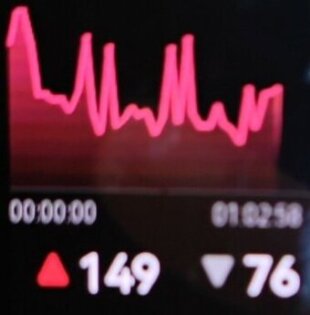
As a result, with the watch optical sensor, the total calories where 776 during the swimming training. A difference of about 200 calories, 33% more than the real ones measured by the Polar H10..
The maximum heart rate measure on the watch was a bit lower 149 bpm then H10.
But, looking to the bpm chart Huawei Band 10 performed very bad. In fact, looking at the chart there was a single big spike in the bpm value.
It was recorded during the 100 meters sprit. For the rest of the traning it recorded only 5 sprint (I made 10 sprints). So it missed 50% of the sprints’ data! Furthermore, excluding the 149 bpm spike, the other sprints recorded had much lower top bpm rate, around 130 bpm.
For free there is no evalution of the cardiac effort of the training. To have it you need to pay a montly fee, but it will be wrong, since the data are missing. So, Huawei Band 10 is almost useless for swimming.
Test day 2, swimming test with the Polar Vantage M3 compared to Polar H10
I went again to a swim training with two heart rate bpm monitor sensors. This time I tested Polar H10 electric chest sensor against Polar sport watch Vantage M3 optical sensor. I made this test to be sure that any smartwatch sensor, even the best, is worse than H10 or Verity Sense upper arm optical sensor. To be 100% sure, I made two test in two different days on day 2 and day 3. Let’s see the first one.

The chart above is with H10 chest sensor and is perfect, no gap and I can see each sprint, exactly how I did the training. Maximum real heart rate was 153 bpm.
The following chart is with Polar Vantage M3 internal optical sensor:

During warm up, Vantage M3 heart rate optical sensor overestimate the beat rate.
The first part of the swimming, the 20 minutes warm up, was recorded with more bpm then the real one recorded on Polar H10. I go very slowly in the first 10 minutes and then gradually I start increasing the speed. You see this clearly in the H10 chart where the bpm during warm up has a range from 115 bpm to 122 bpm . Instead, with the sport watch Vantage M3 the chart is almost flat on 132 bmp level.
On the wrist, the heart rate optical sensor lost several beats and 25 meters sprints.
As you can see, the bpm chart has some gap. But, even worse, during the short sprint, when the sport watch loses the heart beat for fewer time, it creates “fake sub sprint”. You can see the last 25 meters sprints in the chart, Vantage M3 was not able to record them correctly. Each single 25 meter sprit was splint in more sprints, like I was stopping and the starting during the same sprint. These problems were not present during warm up, so for endurance training you can wear just a smartwatch.
I was wearing it properly both the days, so I don’t know why it was losing data, but the economical Huawei Band was even worse. Instead, Verity Sense optical sensor didn’t have this issue, its sensor on the upper arm is more stable (see my first training test).
Training heart load:
- Polar H10 it was 66 .
- Polar Vantage M3, it was 62, so it was 6% lower the the real one.
Maximum bpm
The maximum bpm recorded on Polar Vantage M3 was 143, that is 10 values lower, that is 6.53% lower than the real one with H10.
Average bpm and Total calories
All the sprints had lower maximum bpm on Vantage M3. But strangely, the average bpm was the same for both the sensors. Total calories were also the same.
Training heart rate zones.
Polar H10
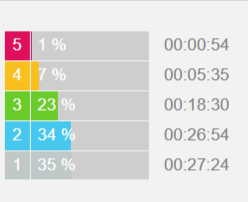
Polar Vantage M3 using the internal optical sensor
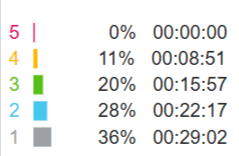
Test Day 3, again Polar H10 compared with Polar sport watch.
I made this second test with Vantage M3 internal optical sensor to confirm the previous results. And there are some confirmation and some differences.

Confirmation:
- As you can see, the warm up was again overestimated (this time much more) on the sport watch (chart below compared to H10 chart).
- The sport watch lost again some heart rate data and several 25 meters sprints (at the end of the swimming).
- The cardiac load was wrong again on the sport watch, but this time was overestimated.
- Total calories was the same for both, but it was the result of two error in the opposite direction in my specific type of training! Warm-up overestimated and swimming sprints not recorded correctly.

Improvements:
- This time the max bpm during the first 100 meters at 80% were the same for both.
Test Day 4, Polar H10 connected to Polar Vantage M3
As you can see from the chart below, in the water, Polar H10 chest sensor connected to Polar Vantage M3 was not able to transfer all the heart rate data from H10 sensor to M3 sport watch.
There are some gaps, but the worst thing was that in all the sprints the maximum heart rate was lost. This issue was very clear to me looking at the end of the training, when I do the 25 meters sprints, the maximum bpm is very low and some sprints has double spike in the bpm.

Conclusions
- As I expected, the best solution for sprint training is an electric heart rate bpm sensor, like Polar H10 or Garmin HRM 600 using their internal logging functionality.
- If you don’t do sprint training, you can use just an optical sensor on the top left arm or under the swim cap. Since, the endurace swimming is recorded correctly on the topo left arm or under the swim cap. It is better than any smartwatch internal optical sensor. Instead, on any smartwatch or sport watch also the endurance swimming data are not reliable. In this case the results could be lower or higher then the real one.
- The optical sensor on the wrist is the worst place to keep the hearts rate sensor. Furthermore, in the water, also the external electrical hear rate sensor lose data when connected to a sport watch. The Bluetooth or Ant+ signals are weak in the water. See in the comments what could solve this problem.
The best way to use the heart sensor, software and watch
I don’t regret to have bought Polar Vantage M3 sport watch, Polar gives you much more free and more sophisticated software with the watch than only buying Polar H10. So, probably I will use this way my new Polar Vantage M3 sport watch and Polar H10 (or Verity Sense) in the water:
- I will start two separate swim training recording, one with the Vantage M3 sport watch and one with an external heart rate monitor (H10 or Verity Sense).
- I will use the sport watch to show me my resting time, to know the distance and my realtime approximated bpm. But, at the end of the training. I will delete his recording.
- I will keep on Polar Flow archive only the one recorded inside the external heart rate monitor (Polar H10 or Verity Sense)
Instead, all the recovery or biological performance tests are much better if you use H10 connected to Polar Vantage M3. I do the Polar orthostatic test for recovery measures and VO2max test useing H10 chest sensor.
For routine training or endurance, I will keep using the optical sensor on the upper left arm (the one near the heart). Since it is more comfortable and easier to carry and wear. Probably the best place to wear it’s under the swim cap, but I don’t wear it.
Polar Verity Sense optical sensor wore under the swim cap:
A friend gave me this chart to show me that Verity Sense works well also under the swim cap with the internal logging. Obviously, this doesn’t solve the issue of lower maximum bpm during short sprint (100 meter, 50 meter and 25 meter).
